America Obscura (4)
By:
November 14, 2016
HILOBROW friend Andrew Hultkrans is a legendary freelance journalist; we have admired his range, erudition, and virtuosity since the early ’90s, when he was a columnist at MONDO 2000. We’re proud to publish this series of essays by Andrew, each of which originally appeared (as noted) elsewhere.
True Lies: “Real” TV
“What you are about to see is real. There are no re-enactments.” — LAPD: Life on the Beat
“Truth Wins” —Dole campaign banner
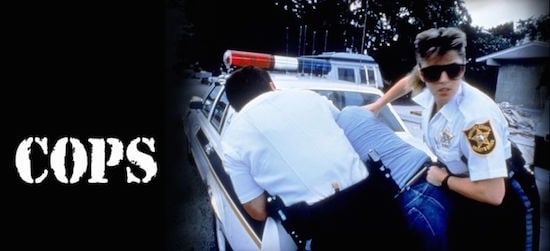
Towards the end of the 1996 presidential campaign, a flagging Bob Dole sought to spin himself as the candidate of “truth” by condemning Bill Clinton as a slick dissimulator pathologically incapable of “telling the truth,” whatever that meant. The galling spectacle of Dole—an utterly compromised career politician—desperately clutching the banner of honesty as if it were one of his omnipresent pencils, reflected the deep cynicism that has infected American politics, from the candidates on down to Joe Bongload, non-voter. This widespread cynicism, far from being confined to the cesspool of politics, colors the transmission of all media-generated images, facts, and news reports—calling their authenticity into question—and thereby creating an unusual demand for an aesthetics of the “the real.” This hunger for “the real” has manifested itself in an ever-expanding genre of “Reality TV,” from Cops to the absurdly oxymoronic Real TV, and the resurgence of the “truth-seeking” art house documentary, exemplified by The Thin Blue Line, Roger and Me, and My Brother’s Keeper. On MTV, hardcore rappers bust rhetorical moves worthy of French theorist Jean Baudrillard in their desperate efforts to represent “the real” through their simulated, studio-gangster fantasies. And in Planet Hollywood, crusading baby-boomer filmmakers attempt to unearth the secret history of their generation in overblown, agenda-heavy epics that blur the boundaries between fact and fiction while purporting to deliver “the real story” behind official accounts (JFK, Malcolm X, Panther, Nixon).
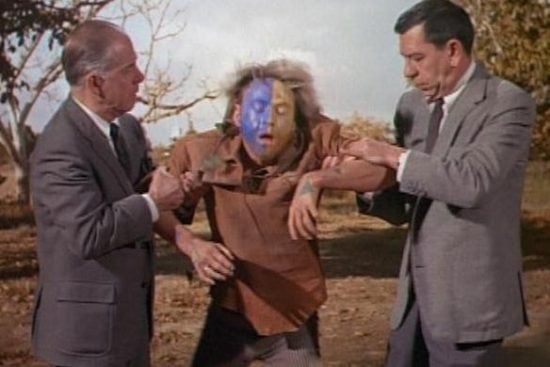
The quaint, naive Dole slogan “Truth Wins” reveals more than its morally bankrupt creators intended. While harkening back to an irretrievable Norman Rockwell era when “honesty” and “values” meant something, the slogan unwittingly points to the use of “truth” as a narrative strategy, an aesthetic spin among many, to be deployed knowingly as a means of producing a desired audience response. Like the video verité camerawork employed in the re-enactments of Real Stories of the Highway Patrol and America’s Most Wanted, “truth” has become a carefully scripted style, an aesthetic of simulation masking the fundamental absence of truth in our spectacular society. The self-conscious use of truth as a narrative hook was pioneered on TV by Jack Webb’s unintentionally campy Dragnet, which promised in stentorian tones that “The story you are about to see is true. The names have been changed to protect the innocent.” That Jack Webb was not actually Sergeant Joe Friday of the Los Angeles Police Department, and that the entire story was a dramatic re-enactment went unmentioned, but this was irrelevant. Webb delivered an unparalleled simulation of authenticity in his deadpan “just the facts, ma’am” acting style, foreshadowing Dole’s equally wooden campaign appearances.
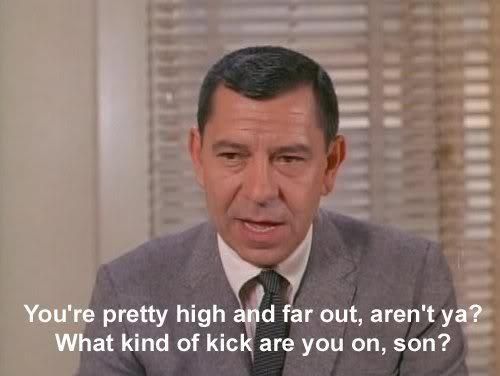
Whereas in the re-enacted Dragnet there was an effort to “protect the innocent,” in contemporary “reality” cop shows such as Cops and LAPD, the often brutalized faces and bodies of suspects are laid bare to a nationwide audience. The announcement at the beginning of Cops that “all suspects are considered innocent until proven guilty by a court of law” is pure window dressing, a token nod to that irritating document that has proved to be an unwanted shackle to modern police since Dirty Harry—the Constitution. After dispensing with this liability disclaimer, surely tacked on by the show’s lawyers, Cops gets down to the business of serving as judge and jury at various fucked-up situations, alchemically turning suspects into felons and further criminalizing the images of the underclass and the African-American community. Reinforcing the thick-necked, black-and-white moral outlook of these shows, the cops constantly refer to their potential suspects as “the bad guys” as if they were starring in a Ronald Reagan film (which, in a sense, they are), a categorization echoed by the “bad boys” theme of Cops. In addition to violently brutal arrests, “the bad guys” are often subjected to gratuitous verbal derision, as in this cartoonish taunt delivered by a cop involved in an outstanding warrant arrest engineered around a fake free television giveaway: “The bad news? No TV. The good news? You’re going to Happyland to play some volleyball.” Not surprisingly, the cops are also given to excessive moralizing and dime-store psychoanalysis between beatdowns, occasionally revealing more about the subtext of the shows than they should—Cop 1: “Wasn’t a bad scuffle.” Cop 2: “Yeah, but I get tired of scuffling with the same guy when the system isn’t taking care of him.”
What shows like Cops and LAPD document are eruptions in the orderly maintenance of this “system”—an omnipresent strategy of surveillance, containment, criminalization, and incarceration—of which Cops itself is a part, posing the question “What you gonna do when they come for you?” if you foolishly decide to buck “the system” yourself. A peculiar effect of these “authentic” police shows is that they produce an audience at once passive and engaged. The relentless parade of violence, stupidity, and half-assed anarchy numbs the viewer to such displays of “disorderly conduct,” making the buckwild seem banal, while simultaneously creating “a nation of finks,” to quote William S. Burroughs, an audience of armchair detectives, witnesses, and informants. Not surprisingly, the video fantasy of power and authority displayed in Cops has begotten interactive “fink” shows like America’s Most Wanted and Unsolved Mysteries, which encourage viewers to police themselves in a postmodern version of Jeremy Bentham’s infamous Panopticon prison.
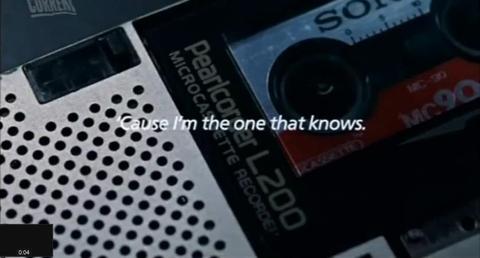
Nowhere is this effect better personified than by a self-proclaimed eyewitness in The Thin Blue Line, a self-consciously arty documentary about an extremely fishy cop killer trial in Texas. An unabashed redneck with feathered, bottle-blonde hair, this “witness,” whose testimony was instrumental in convicting the wrong man of murder, explains her involvement to the filmmakers without a trace of irony or self-awareness: “When I was a kid, I used to want to be a detective all the time cause I used to watch all the detective shows on TV. … I’m always looking because I never know what might come up or how I could help. I like to help in situations like that. … And it’s always happening to me everywhere I go. Lots of times there’s killings or anything, you know? … And I’m always looking or getting involved, finding out who did it or what’s going on. … I’m always trying to decide who’s lying or who killed who before the police do, to see if I can beat ’em.” Having successfully indoctrinated its audience with an internalized urge to police, Cops becomes nothing more than violent entertainment whose “authenticity” is immaterial. This result was foreshadowed by a prescient George Lucas in his THX 1138, where a TV channel of the future consists solely of Rodney King-style police beatdowns, apparently for the purpose of mindless diversion.
Ironically, the urge to “beat” the police at their own game is shared, after-the-fact, by the makers of The Thin Blue Line themselves. Like the social problem documentaries of the New Deal era, but with a decidedly postmodern twist, the film seeks to redress the wrongs done to an individual by the State, to help him “beat the rap,” so to speak. Employing talking head interviews with all the major participants intercut with stylized, minimalist re-enactments of the murder event itself, the film is a meditation on the unreliability of memory and the contingent nature of truth, while offering a meta-commentary on documentary filmmaking. Despite the self-conscious artifice of the re-enactments, the film positions itself as an arbiter of “truth,” while paradoxically undercutting the authority of film to present “reality” as it happened. The film wants to have it both ways—the “truth” is relative, events are in the eyes of the beholder, no recollections are identical, yet by revealing the unreliability of memory to reflect history by employing an aesthetic of artifice, a larger “truth” can be revealed, and thereby, an injustice can be undone. While the paradoxes of The Thin Blue Line are unsettling, the film at least avoids the revisionist pitfalls of Oliver Stone, Spike Lee, Mario Van Peebles and others with its “Look, Ma! I’m manipulating the audience!” disclaimer aesthetic. For these Hollywood directors, history is merely a first-draft script, open to endless rewrites and unbridled artistic license.
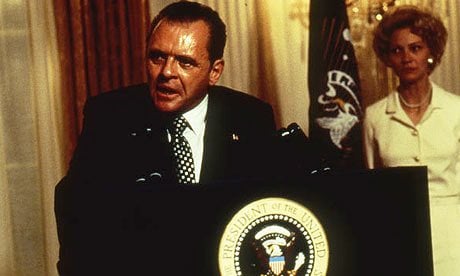
Just as “truth” has become a narrative style, there is no doubt that history itself is contingent, mutable, and a matter of perspective. Howard Zinn’s A People’s History of the United States proved this most decisively, rewriting American history from the downtrodden viewpoint of the colonized and disenfranchised to produce a photo-negative narrative barely recognizable to students of public school history teachers. Nevertheless, the dramatic re-enactments of recent history offered by such films as JFK, Malcolm X, Panther, and Nixon present historical events through the filter of Hollywood convention while boldly claiming to represent “the real story” suppressed by the powers-that-be. All of these films freely blend actual historical footage with cinematic recreations in a manipulative manner reminiscent of propaganda, yet none contain the meta-discourse present in The Thin Blue Line that becomes, and critiques, such cinematic manipulation. Thus, while thoroughly postmodern in form—employing collage, mixed media, relativistic juxtapositions of real and fake—these films actually belong to an earlier, modernist era of the Big Truth, which, though disguised from the general public, can be unearthed and expressed by the Great Artist.
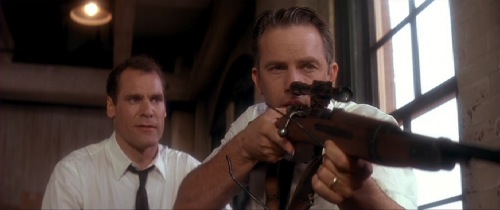
While it is hard to dispute that John F. Kennedy was the victim of an assassination conspiracy, that the rogue assassins in the Nation of Islam who shot Malcolm X were on the payroll of the Federal Bureau of Investigation, that the Black Panthers were neutralized by the strategic deployment of drugs into the ghetto by the FBI’s COINTELPRO program, that Nixon’s criminal machinations were related to the big money concerns of the Military Industrial Complex, the filmmakers present these suppressed conspiracies as unquestionable fact, as if to say, like the producers of LAPD: “What you are about to see is real. There are no re-enactments.” In fact, not only are the majority of known historical events re-enactments—tweaked for maximum dramatic effect—these films “re-enact” scenes which are not recorded anywhere, filling in the holes in the conspiracy theories upon which the films are based. Nowhere do the filmmakers say, “This is my interpretation of what may have happened,” nor do they say, as does The Thin Blue Line, “Everything is someone’s interpretation of what may have happened.” Instead, drunk with the manipulative power of film, these directors declaim: “Forget what you saw on the evening news, this is what really happened.” It is ironic, yet strangely appropriate, that the majority of real history in JFK—actual period newscasts, footage of Martin Luther King, the assassination of Bobby Kennedy—appears on TV in the living room of Kevin Costner’s character, Jim Garrison, reversing the reality principle and reminding us that, since the 1950s, most of our memories of important events are television images.
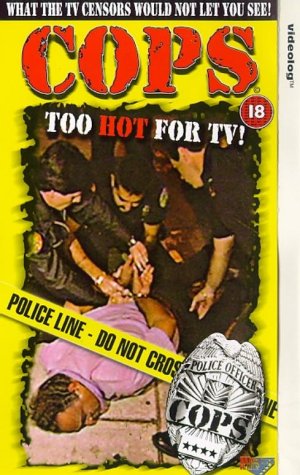
One can only hope that Hollywood has exhausted the list of controversial 1960s events to exhume and re-enact (Oliver Stone has already taken care of most of them), yet “Reality TV” shows no sign of obsolescence. New “reality-based” shows proliferate. Cops has turned out a series of best-selling videos, one of which—Cops: Too Hot for TV—contains a clip that neatly summarizes the near-total erasure of the boundaries between truth and fiction hastened by these shows and films. Among its many charms, Too Hot for TV differs from regular episodes by giving voice to the harassed suspects, if only to expose their laughable intoxication or frothing hatred. “Don’t put your fucking dick in my ass, you cocksucking faggot whores!” pleads one less-than-compliant detainee. “You want to buttfuck me. … I was fine until you decided to molest me,” observes another. But most telling of all are the reactions of one drunk woman to her arrest: “Is this Hidden Video? I watch Hidden Video all the time.” After being assured that the police are not from Hidden Video, and that “this is not a joke,” the woman, totally adrift in the reality/fiction continuum, continues hopefully, “Are you a celebrity? Are you like Matlock?” The answer, both yes and no, is more complicated than she could ever imagine.
Originally published by the web magazine STIM, January 1997.
CURATED SERIES at HILOBROW: UNBORED CANON by Josh Glenn | CARPE PHALLUM by Patrick Cates | MS. K by Heather Kasunick | HERE BE MONSTERS by Mister Reusch | DOWNTOWNE by Bradley Peterson | #FX by Michael Lewy | PINNED PANELS by Zack Smith | TANK UP by Tony Leone | OUTBOUND TO MONTEVIDEO by Mimi Lipson | TAKING LIBERTIES by Douglas Wolk | STERANKOISMS by Douglas Wolk | MARVEL vs. MUSEUM by Douglas Wolk | NEVER BEGIN TO SING by Damon Krukowski | WTC WTF by Douglas Wolk | COOLING OFF THE COMMOTION by Chenjerai Kumanyika | THAT’S GREAT MARVEL by Douglas Wolk | LAWS OF THE UNIVERSE by Chris Spurgeon | IMAGINARY FRIENDS by Alexandra Molotkow | UNFLOWN by Jacob Covey | ADEQUATED by Franklin Bruno | QUALITY JOE by Joe Alterio | CHICKEN LIT by Lisa Jane Persky | PINAKOTHEK by Luc Sante | ALL MY STARS by Joanne McNeil | BIGFOOT ISLAND by Michael Lewy | NOT OF THIS EARTH by Michael Lewy | ANIMAL MAGNETISM by Colin Dickey | KEEPERS by Steph Burt | AMERICA OBSCURA by Andrew Hultkrans | HEATHCLIFF, FOR WHY? by Brandi Brown | DAILY DRUMPF by Rick Pinchera | BEDROOM AIRPORT by “Parson Edwards” | INTO THE VOID by Charlie Jane Anders | WE REABSORB & ENLIVEN by Matthew Battles | BRAINIAC by Joshua Glenn | COMICALLY VINTAGE by Comically Vintage | BLDGBLOG by Geoff Manaugh | WINDS OF MAGIC by James Parker | MUSEUM OF FEMORIBILIA by Lynn Peril | ROBOTS + MONSTERS by Joe Alterio | MONSTOBER by Rick Pinchera | POP WITH A SHOTGUN by Devin McKinney | FEEDBACK by Joshua Glenn | 4CP FTW by John Hilgart | ANNOTATED GIF by Kerry Callen | FANCHILD by Adam McGovern | BOOKFUTURISM by James Bridle | NOMADBROW by Erik Davis | SCREEN TIME by Jacob Mikanowski | FALSE MACHINE by Patrick Stuart | 12 DAYS OF SIGNIFICANCE | 12 MORE DAYS OF SIGNIFICANCE | 12 DAYS OF SIGNIFICANCE (AGAIN) | ANOTHER 12 DAYS OF SIGNIFICANCE | UNBORED MANIFESTO by Joshua Glenn and Elizabeth Foy Larsen | H IS FOR HOBO by Joshua Glenn | 4CP FRIDAY by guest curators
